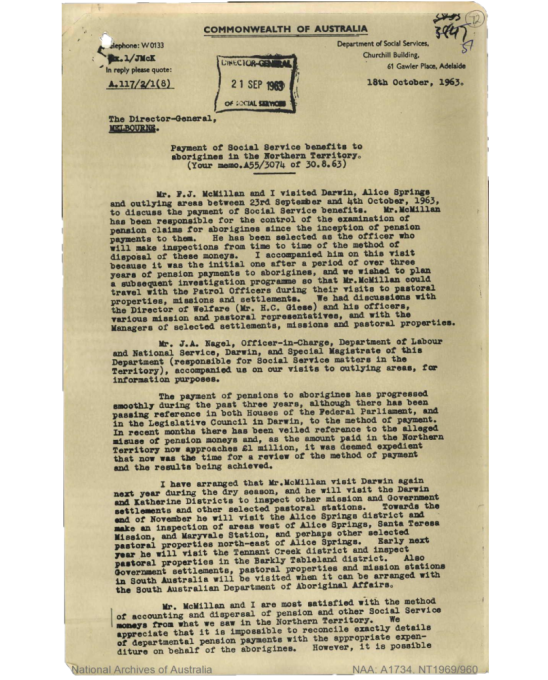
Officials report on payment management on missions and stations
Government officials reported on how managers of missions, stations and settlements were using government payments for Aboriginal people in the Northern Territory. They collected minimal information from Aboriginal payment recipients.
there has been veiled reference to the alleged misuse of pension moneys and … it was deemed expedient that now was the time for a review of the method of payment and the results being achieved.
| Attachment | Size |
|---|---|
| atkinson-mcmillan-reports-on-payment.pdf | 5.88 MB |
| Attachment | Size |
|---|---|
| atkinson-mcmillan-reports-plaintext.docx | 84.33 KB |
Many Aboriginal people became eligible for payments under changes to the Social Services Act 1959. However, in the years following, the government sent payments to property managers where Aboriginal people lived instead of to people directly. Managers then decided how much of the money was used for essentials like food and housing. Some gave a small amount to Aboriginal residents as ‘pocket money’.
In the 1960s, Director of Social Services in Adelaide, CG Atkinson, and Special Magistrate FJ McMillan visited properties in the Northern Territory to see how payments, especially Old-age Pension payments, were managed. These excerpts are from their reports about their visits.
Initial visits find discrepancies in payment management
In 1963, Atkinson and McMillan visited various property types, including missions, stations and settlements, across the Northern Territory. They found that money was managed differently at each property.
They reported that staff of the Northern Territory Department of Welfare thought people should get more in pocket money, but that managers of properties were against this idea. Managers thought that higher government payments would mean people wouldn’t want to work. They also thought people would share their money with family members, or use it to buy alcohol, ride in taxis or gamble.
Atkinson and McMillan recommended a standard base rate of pocket money and that the managers increase this rate over time. However, they also concluded that ‘most of the pensioners are receiving value for their pension payments’.
In their reports from this visit, neither Atkinson nor McMillan mentioned what Aboriginal people themselves thought of their finances.
Follow-up visits reveal reluctance to allow self-management
McMillan visited another 20 stations around Alice Springs the following year. His impression was that ‘the lot of the majority of Aboriginal pensioners is gradually improving’.
McMillan took detailed notes about managers and the number of Aboriginal pensioners living on each property. He recorded how managers used payments and how much pensioners got directly.
He again found that the conditions for pensioners differed greatly between properties. Only a few pensioners got their full payment to manage themselves. Where the managers were paying ‘pocket money’, McMillan reminded them of their responsibilities and asked them to increase the amount.
As before, some managers were reluctant to increase the amount of pocket money they paid, often because they didn’t think Aboriginal people could manage their own money. For example, at Willowra station, McMillan reported that manager Edgar Parkinson thought Aboriginal people in his area were ‘fairly backward’ and believed they would spend money on ‘non-essentials’. This would be proven untrue. Within the next decade, Walpiri people would pool their government payments to buy the property back from Parkinson when he retired.
Unlike in the earlier visit with Atkinson, McMillan recorded at least 2 instances where he spoke directly to Aboriginal pensioners during these inspections. He said that at Erldunda pensioners ‘expressed satisfaction with the allotment of money and rations’ and that at Ti Tree one pensioner confirmed he was getting his payment.
The reports show only minimal interest from government officials about Aboriginal perspectives. They also show their attitude that Aboriginal people shouldn’t get their payments directly unless they used the money in ways they thought appropriate.
The issue of direct payments for Aboriginal people continued to be discussed by government and activists in the following years.
These reports and associated correspondence were kept in a file by the Department of the Interior. The file was later transferred to the National Archives of Australia, which holds it as part of the national archival collection.
You can access the file through RecordSearch. Go to pages 145–164 and 226–235.
Permissions
Unofficial names used in the report have been omitted, otherwise no individuals were identified in these excerpts. As the reports covered numerous places across the Northern Territory, it was not possible to seek community permissions for use of the excerpts here.
Citation
National Archives of Australia: Department of the Interior; A1734, Correspondence files, 1933–1980; NT1969/960, Social Service Benefits for Aborigines – Northern Territory, 1964–1966.
